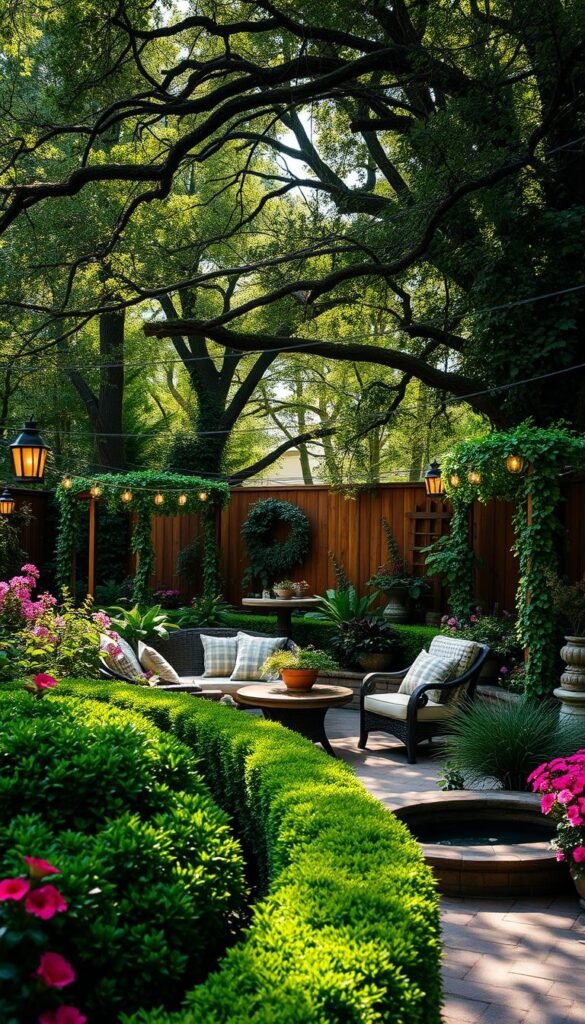Ready to turn your yard into a personal oasis? Whether you’re dreaming of cozy corners for morning coffee or lively spaces for weekend gatherings, smart design choices can elevate any plot of land. This guide offers fresh inspiration for homeowners looking to reimagine their green spaces without breaking the bank.
You’ll find solutions tailored to different needs—from space-saving vertical planters that maximize small patios to weather-resistant furniture perfect for year-round use. No matter your climate zone or square footage, these strategies help create functional, inviting environments that reflect your unique taste.
We’ve prioritized ideas that blend aesthetics with practicality. Think multipurpose seating with hidden storage or native plants that thrive with minimal care. Every suggestion balances visual appeal with real-world usability, ensuring your revamped garden becomes a natural extension of your home.
Welcome to Your Dream Outdoor Escape
Picture a retreat where every detail reflects your personality and lifestyle. Your garden isn’t just grass and shrubs—it’s where summer laughter echoes and quiet sunsets recharge your spirit. Thoughtful planning turns this space into a natural extension of your home, blending comfort with creativity.
Great outdoor areas work like chameleons. By day, they’re perfect for reading nooks with comfy seating. By night, they transform into entertainment hubs under string lights. As one landscape architect puts it:
“The magic happens when spaces adapt to life’s rhythms without losing their charm.”
Three elements make gardens special:
| Purpose | Smart Feature | Benefit |
|---|---|---|
| Relaxation | Weather-resistant lounge chairs | Comfort in all seasons |
| Entertaining | Modular seating | Flexible layouts |
| Personal Style | DIY planter boxes | Budget-friendly customization |
You don’t need fancy tools to start. A simple gardening aesthetic approach lets you experiment with colors and textures gradually. The key? Let your space evolve as you discover what brings you joy under open skies.
Assess Your Current Outdoor Space
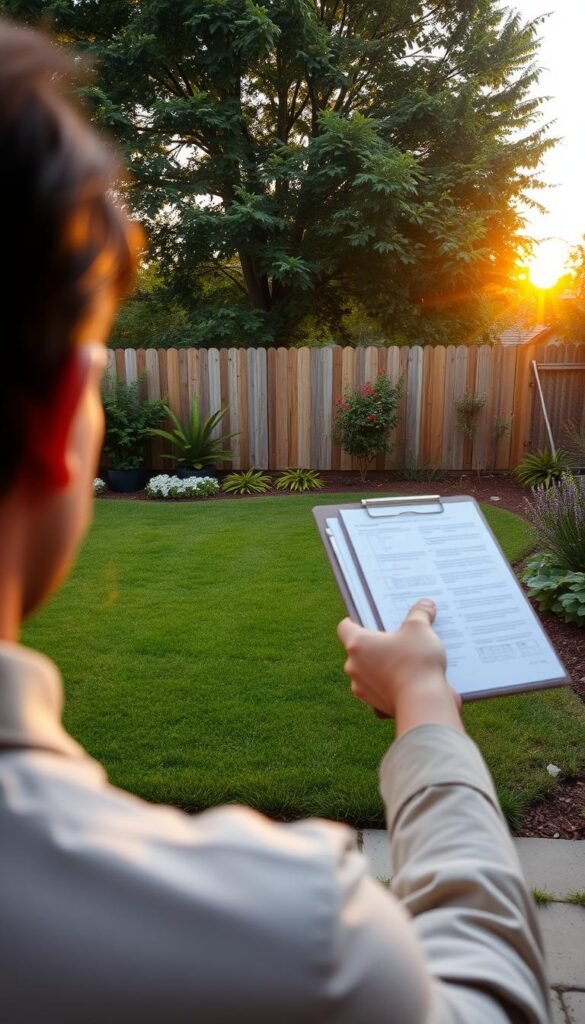
Understanding your yard’s potential begins with a clear-eyed evaluation. Grab a notebook and walk through your space like it’s your first visit. Notice where sunlight dances across the ground at noon and where shadows linger in the afternoon—these details shape your design possibilities.
Evaluate Your Landscape Layout
Measure every corner of your backyard, including permanent features like trees or slopes. Sketch a rough map showing drainage patterns and property lines. This helps avoid costly mistakes later. Ask yourself: Does rainwater pool near the patio? Do mature trees block evening light?
Identify Your Priorities
List your family’s top needs—rank them ruthlessly. A pizza oven might sound fun, but will it crowd out space for toddler playdates? Balance practical wants (storage benches) with emotional needs (a flowering cherry tree for spring blooms).
| Focus Area | Key Questions | Tools Needed |
|---|---|---|
| Sun Exposure | Where does sunlight hit longest? | Compass, timer app |
| Usage Patterns | Which areas feel cramped or unused? | Traffic flow notes |
| Family Needs | What activities matter most weekly? | Priority ranking list |
One homeowner shared:
“We almost built a fire pit where our dog’s favorite digging spot was—glad we checked first!”
Yourspaceshould serve daily life, not just special occasions. Keep that coffee-stained list handy—it’ll guide every decision ahead.
Visualize Your Garden’s Style and Function
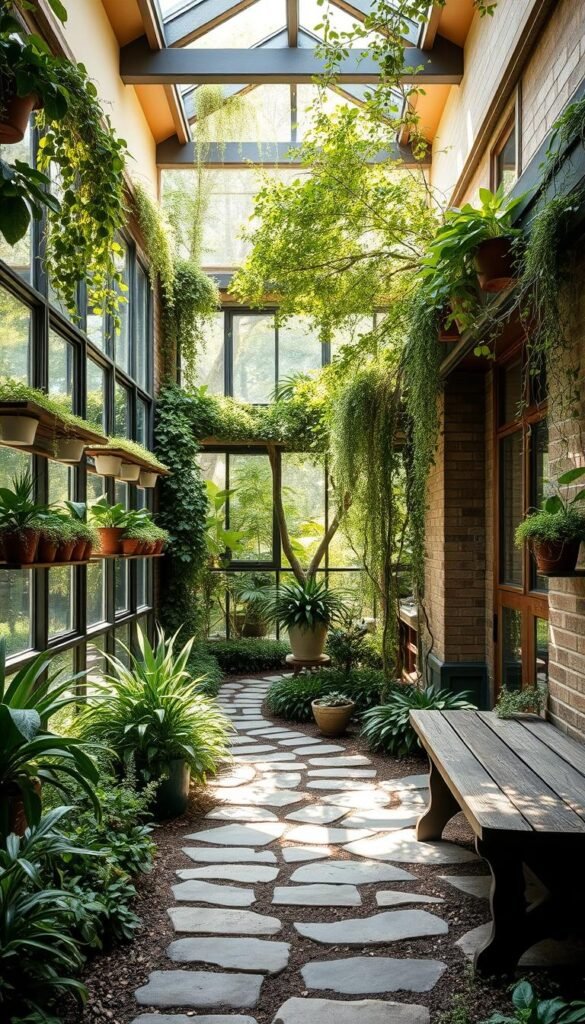
Imagine stepping outside to a space that feels like a natural continuation of your living room. Blurring indoor-outdoor boundaries creates harmony while making both areas feel larger. Start by repeating design elements from your home’s interior—like matching cushions or wood finishes—to build a visual bridge between spaces.
Blend Indoor-Outdoor Living
French doors aren’t just charming—they’re practical portals connecting daily life to nature. Consider these strategies:
| Design Strategy | Benefit | Budget Tip |
|---|---|---|
| Matching floor materials | Creates seamless transitions | Use indoor tile remnants outdoors |
| Container plants near entries | Softens architectural lines | Repurpose old buckets as planters |
| Large windows | Brings sunlight deep indoors | Install mirror panels to reflect views |
One designer notes:
“Your patio should whisper ‘welcome’ whether you’re hosting friends or enjoying solitude.”
Create zones that mirror indoor activities. A breakfast corner with weatherproof stools near the kitchen? Perfect for quick meals. For evening gatherings, position lounge chairs where sunset light lingers. Don’t forget small touches—a vintage side table adds character while holding drinks.
Your garden’s style should feel intentional yet adaptable. Choose plants that thrive in your climate, and furniture that withstands seasons. When spaces flow together naturally, every moment outdoors feels like coming home.
Plan a Practical Layout for Small Backyards
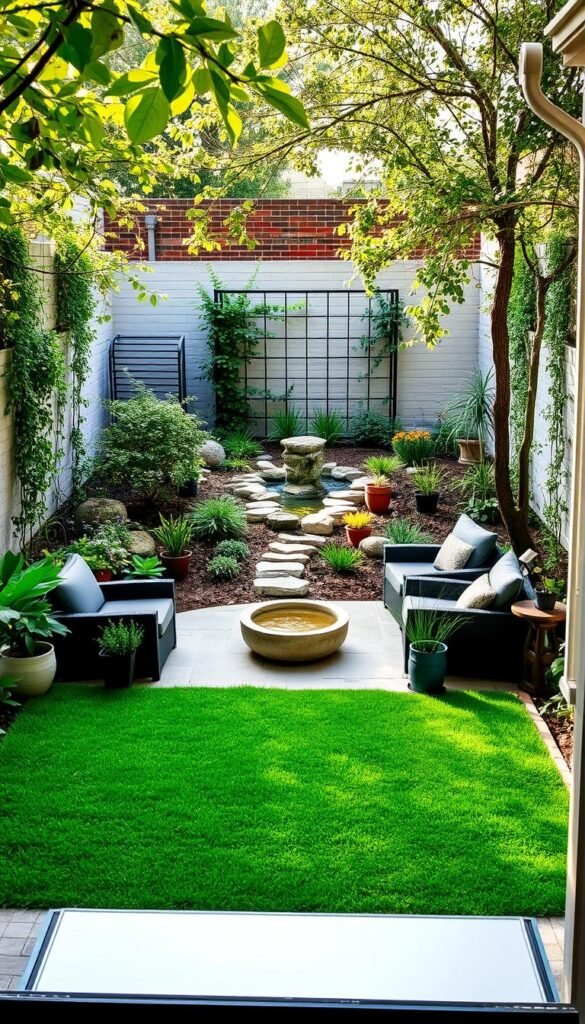
Limited square footage doesn’t mean sacrificing style or comfort—it’s an invitation to get creative. Smart organization turns cramped backyard zones into efficient, multi-use environments that feel larger than they appear. Start by sketching your space to visualize how each element contributes to daily enjoyment.
Maximize Every Square Foot
Think like a puzzle master when arranging your yard. Vertical solutions like wall-mounted herb racks or foldable benches keep pathways clear while adding utility. Here’s how to stretch your area:
- Use tiered planters to grow herbs and flowers without floor space
- Install sliding furniture that tucks against walls when unused
- Mark walking paths with decorative stones to prevent clutter
| Challenge | Space-Saving Fix | Bonus Benefit |
|---|---|---|
| Narrow walkways | Hanging lanterns | Adds evening ambiance |
| No dining room | Fold-out countertop | Doubles as potting station |
| Limited storage | Bench with hidden compartment | Holds cushions/tools |
A landscape designer shares:
“Tiny backyards thrive when every feature serves two purposes. That planter? It’s also a room divider.”
For gardens, consider a square foot garden layout—it organizes crops efficiently while keeping maintenance manageable. Remember: clear traffic flow makes compact spaces feel generous, letting you host friends or unwind without tripping over decor.
Discover 12 Back Garden Ideas to Transform Your Outdoor Area
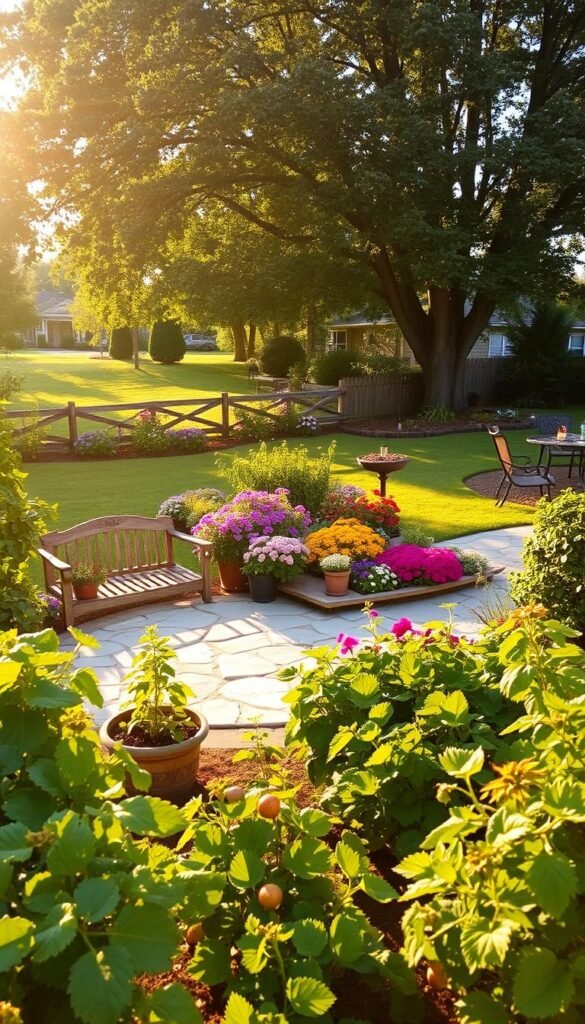
Your outdoor space holds untapped potential waiting to bloom. Let’s explore fresh concepts that balance beauty with purpose, turning overlooked corners into cherished spots. Whether you crave low-maintenance charm or crave vibrant gathering zones, these approaches adapt to your lifestyle effortlessly.
Vertical planters instantly elevate small patios, letting herbs and flowers thrive upward instead of outward. For larger yards, consider curved gravel paths that guide visitors through blooming flower beds. Both solutions tackle spatial challenges while adding visual interest without overwhelming maintenance.
Struggling with privacy? Try these clever fixes:
- Fast-growing bamboo screens create natural barriers in weeks
- Hanging curtain panels on pergolas for adjustable shade
- Multi-tiered plant stands that double as room dividers
| Idea | Key Benefit | Effort Level |
|---|---|---|
| Solar-powered water features | Adds soothing sounds | Weekend project |
| Modular deck tiles | Instantly upgrades old concrete | 2-hour install |
| Color-changing LED stakes | Sets mood lighting | 15-minute setup |
A landscape designer shares:
“The best garden ideas grow from understanding how you truly use your space daily—not just on holidays.”
Start with one change that excites you most. Maybe it’s building a fire pit seating circle or planting native wildflowers. As you layer these backyard enhancements, you’ll create a living canvas that evolves with your needs.
Embrace Vertical Gardening for Height and Depth
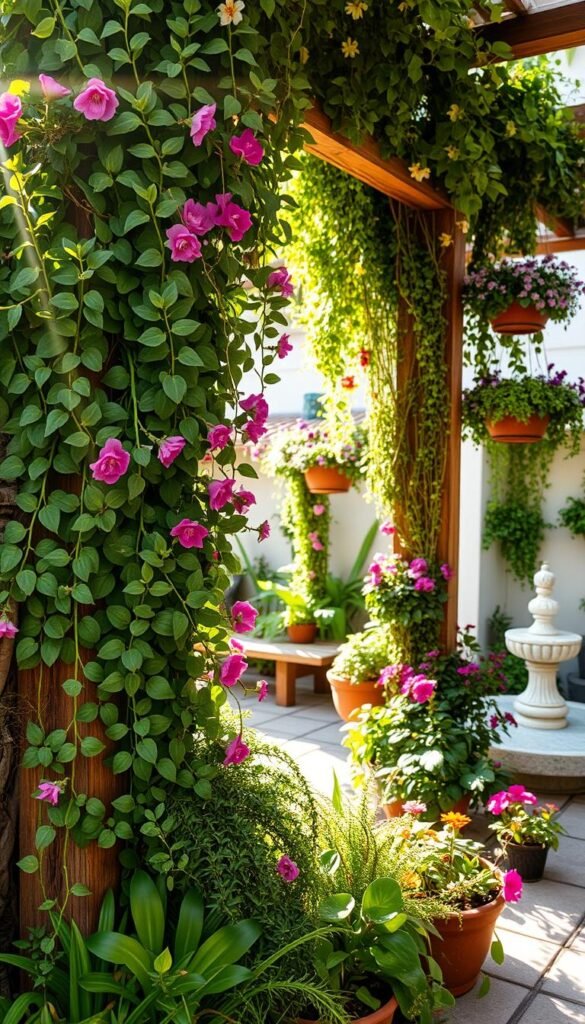
Look up—your garden’s next frontier isn’t on the ground. Vertical gardening turns walls, fences, and railings into lush canvases that add dimension to even the tiniest plots. This approach lets you triple your growing area while creating eye-catching focal points.
Why Go Vertical?
Climbing plants and stacked planters solve common small-space headaches. They block unsightly views, reduce noise, and keep herbs within arm’s reach of your grill. Studies show vertical setups can lower nearby surface temperatures by up to 10°F during summer.
Smart Solutions for Airy Spaces
Start simple: hang pocket planters on a sunny wall for strawberries or salad greens. For bigger impact, try these ideas:
- Repurpose old ladders as tiered stands for potted flowers
- Train ivy along wire grids to create living room dividers
- Mount gutter systems along fences for shallow-rooted plants
| Vertical Solution | Best For | Maintenance Level |
|---|---|---|
| Freestanding trellis | Cucumbers, beans | Low (weekly checks) |
| Hanging herb garden | Basil, thyme, mint | Medium (daily watering) |
| Modular living wall | Succulents, ferns | High (drip system needed) |
A urban gardener notes:
“My vertical garden gives me fresh peppers all summer—and hides the dumpster behind my apartment.”
Remember to match plants to your wall’s sunlight exposure. South-facing surfaces suit tomatoes, while ferns thrive on shaded north sides. With smart vertical layers, your space becomes a functional masterpiece.
Incorporate Hardscaping Elements for a Modern Touch
Hardscaping isn’t just practical—it’s the secret to a polished outdoor retreat. By blending materials like concrete pavers and natural stones, you create structure that elevates your entire design. These elements act as your garden’s backbone, defining walkways and gathering spots with clean lines.
Mix textures for visual drama. Pair smooth poured concrete with chunky gravel borders along your patio. This contrast adds depth while keeping maintenance low. A landscape designer shares:
“Great hardscaping works like stage lighting—it directs attention to your garden’s best features.”
Smart material choices solve multiple needs:
| Element | Best Use | Style Tip |
|---|---|---|
| Concrete pavers | Main pathways | Arrange in geometric patterns |
| Pea gravel | Seating areas | Contrast with dark mulch |
| Flagstone | Natural steps | Leave gaps for creeping thyme |
Built-in stone benches double as retaining walls, saving space while adding seating. For narrow yards, use vertical stones stacked into planters—they’ll hold soil and create privacy screens. Remember: every path should guide the eye toward something beautiful, whether it’s a fire pit or flowering shrub.
Durable materials like brick or pavers withstand weather changes, keeping your space functional year-round. Start small—edge one garden bed with slate chips or frame your grill area with concrete blocks. These subtle touches build a cohesive look that feels intentional, not accidental.
Design Inviting Outdoor Rooms and Zones
Your backyard becomes more than just a lawn when you divide it into purposeful zones. By creating dedicated rooms for dining, relaxing, and socializing, you craft an outdoor space that adapts to daily life. A simple arrangement of potted plants or textured rugs can mark transitions without walls.
Define Dining and Relaxation Areas
Outdoor rugs work like magic to anchor different activities. Place one under your grill station and another beneath lounge chairs—suddenly, you’ve got distinct rooms for cooking and unwinding. Built-in benches around a fire pit save space while offering hidden storage for cushions or tools.
Consider these zoning strategies:
| Element | Purpose | Pro Tip |
|---|---|---|
| Low hedges | Visual separation | Use lavender for fragrance |
| Pergola | Defines seating areas | Add curtains for privacy |
| Gravel vs. decking | Flooring contrast | Use edging strips to contain materials |
A landscape architect suggests:
“Design each zone for its prime time—morning coffee spots need east-facing seating, while dinner areas crave sunset views.”
Built-in seating along fences or planters maximizes capacity in tight yards. Add weatherproof cushions in bold patterns to make these permanent features feel inviting. For evening gatherings, position string lights above dining tables and solar lanterns along pathways to connect your outdoor rooms seamlessly.
Select the Perfect Plants and Greenery
Fresh flavors and vibrant colors start with smart plant choices right outside your door. Whether you’re spicing up weeknight dinners or creating a pollinator paradise, your selections should balance beauty with practicality. Consider sunlight patterns, watering needs, and how each plant serves your lifestyle.
Year-Round Herbs Made Simple
Take inspiration from bloggers Alice and Louis, who grow basil and rosemary outdoors summer through fall. When frost arrives, they move potted herb gardens indoors near sunny windows. This approach keeps flavors fresh in meals year-round.
Raised garden beds simplify this process for beginners. Their elevated design improves drainage and reduces back strain during harvests. Place compact versions on patios or balconies—no sprawling yard required.
Beyond herbs, themed groupings add personality. Try fragrant lavender near seating areas or native wildflowers to attract butterflies. These plant clusters create visual impact while supporting local ecosystems.
Remember: successful herb gardens thrive when matched to your climate. Start with hardy varieties like thyme or mint, then experiment with exotic flavors as confidence grows. Your raised garden becomes both pantry and sanctuary.

